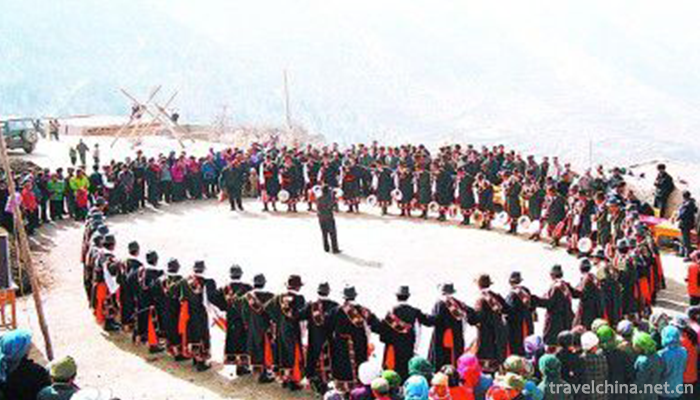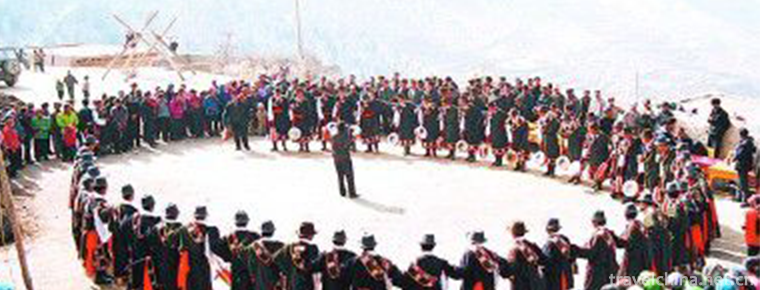Gell
Gell
"Gar", which means singing and dancing in Tibetan, also means "music and dance", because performing Gar has accompaniment of special instruments. On the staff roster of the Tibetan local government, it is called "Dianzhen Garry", which is for music and dance in the clouds. Gaal mainly appeared in large-scale celebrations and occasions such as welcoming the Dalai Lama and Panchen Masters, and other occasions can not be performed at will.
On June 7, 2008, "Gar" declared by the Tibet Autonomous Region was listed in the second batch of national intangible cultural heritage list with the approval of the State Council. Number 682 III-85.
historical origin
Tibetan "Garqiang Mother" means performing dances. Some people used to call Garqiang Mother "the God dancing of religion", "the law dance of religion", "the religious Qiang Mother" and so on, but there are two basic different traditional appellations for this art in various religious schools of Tibetan Buddhism, one is "Garqiang Mother" by other sects except the Gelug sect, and the other is "Sangwei Duoji Garqiang Mother" by the Gelug sect, which means "performing the Vajra Dance of Mizong". Because of their historical origins and the different instrumental music accompanied by their performances, they are called "Aqiang Mother" and "Tongqiang Mother" respectively. The performances of "Aqiang Mother" mainly consist of various drums and cymbals as the main musical instruments, while the performances of "Tongqiang Mother" consist of various brass wind instruments as the main musical instruments. In addition, the historical origin of "Aqiang Mother" was earlier than "Tongqiang Mother". According to legend, in the eighth century AD, Master Lotus and Peanut repressed the enemy of Buddhism, such as Zanab, and achieved this goal by using folk God dance at that time and combining Buddhist sect magic. Since then, when Tibetan Buddhist factions held this activity, there was a statue of the devil called "Lingka" in the tree, and the lamas of Sangye Temple called him "Ruzanab". Whether they are "mother of Aqiang" or "mother of Tongqiang", the basic content they represent is that all kinds of guardian gods suppress the devil.
artistic characteristics
Suitable occasion
Balang encourages people to perform on the fifth to fifteenth day of the first lunar month during the Spring Festival. From the sixteenth day of the first lunar month, the Balang drum will be offered high for use in the coming year. Zhuoni Tibetan calls Balang drum "Shamu". Its place of activity is called "Shamu Stadium", and the day of performing Balang's inspiration during the first month is called "Manla Festival". At that time, each village will be composed of men, young and old, "Sham Team". In addition to dancing and singing in their own village, they will also go to neighboring villages to catch up with the "Manla Festival" for communication. The loud drums and vigorous dancing add endless joy to the Spring Festival.
Form of performance
Before the performance began, a campfire was set up in the center of the "Sha Mu Chang", where tables, chairs and benches were placed for the elderly, who were in charge of the activities. Young people pour tea and pour wine. They are busy before and after running. Children are chattering all over the courtyard. It's a festive scene. Towards dusk, the whole village arrived and a deacon announced the beginning of the performance. The "Shamus Team" danced around the campfire, shaking the balang drum. First singing the prelude "Gentle", then dancing "Kusong Gary", three times in a question-and-answer way to greet each other; then dancing while singing "Shalou Meilou", meaning "Sha Mu" text begins. Following are Spring Bud Spring, Spring Column, Nizhi Dao Yang and so on. The lyrics include congratulations on harvest and festivals, praises of natural beauty and good people and good deeds in their hometown, criticisms of current problems, and guessing fancy pan songs. So they sang until the night wore on. The cock announced the dawn. The host was going to invite the "Sha Mu Team" into the most spacious hall, and the families brought out plentiful festival food and barley wine to entertain the guests. At this time, the representative of the host raised his glass and asked "Long Sufficiency", "Samaru" (Dinner Song), and "Zamaru" (Wine Song). The guests immediately answered with the song, singing to each other, and the climax was repeated. During the festival, married young and old girls return to their mothers'homes, gather together with their families and neighbors, dance "Anisan" and sing "Tongka" songs, and celebrate the New Year in high spirits. In the midst of the morning light, the main guests gathered at the "beach yard", held a farewell ceremony, danced "Gailu", and wished each other a good harvest in the coming year. At this point, the "Manla Festival" of a village is over, and the "Team" is actively preparing to go to the next village to celebrate the "Manla Festival". Balang encourages ruggedness and fitness, and has a strong sense of rhythm and strong romantic local ethnic characteristics.
Inheritance significance
Gal has a long history, beautiful dance shape, unique music style, is a unique etiquette of men's comfortable singing and dancing art.


-
1.Shanghai
People's Republic of China municipality directly under the central government
Time 2018-10-12 -
2.Mount Heng
Mt. Hengshan, also known as "Tai Mt. Hengshan", is known as "Xuanwu mountain" and "Yushan". Among them, inverted Ma Pass, Bauhinia Pass, Pingxiaoguan Pass, Yanmen Pass
Time 2018-10-30 -
3.Beigushan HillBeigu Mountain
Beigu Mountain, one of the three scenic spots in Zhenjiang, overlooks Beigu, pillows the river, rocky walls, and the mountain is dangerous, so it is named Beigu Mountain
Time 2018-12-06 -
4.West Lake Scenic Spot in Hangzhou
Hangzhou West Lake Scenic Spot is located in the center of Hangzhou City, Zhejiang Province. It is divided into lakeside area, Lake Center area
Time 2018-12-07 -
5.Beijing Hotel
Located in the center of Beijing, Beijing Hotel is adjacent to the former Imperial Palace and Forbidden City. It can reach Tiananmen, the Great Hall of the People
Time 2018-12-14 -
6.Shanghai Ocean Aquarium
Shanghai marine aquarium is located at 1388 Lujiazui Ring Road, Pudong New Area, Shanghai, China, next to the Oriental Pearl Tower. Singaporean Xingya Group and Chinese Poly Group have jointly
Time 2018-12-19 -
7.Luonan Jing Blackboard
In 2011, Luonan Jingbanshu was approved by the State Council and listed in the third batch of national intangible cultural heritage list. As early as in the Daoguang period of the Qing Dynasty (around
Time 2019-05-15 -
8.Shandong drum
In addition to the book drum, the musical instruments of Shandong drum were initially beaten with two pieces of plough and plough, and then two pieces of iron and copper were used, accompanied by thre
Time 2019-06-13 -
9.Wuqiao acrobatics
Wuqiao acrobatics is a traditional folk acrobatics art in Hebei Province. Referring to the "acrobatics town" people are often referred to as Wuqiao County, Cangzhou City, Hebei Province. Acc
Time 2019-06-29 -
10.Firing Techniques of Zibo Ceramics
During the Wei, Jin, Southern and Northern Dynasties, Zibo began to produce porcelain. During the Tang and Song Dynasties, the technology of making porcelain was constantly improving. During the Ming
Time 2019-08-16 -
11.Xiling Snow Mountain
Xiling Snow Mountain, located in Dayi County, Chengdu City, Sichuan Province, is only 95 kilometers away from Chengdu, with a total area of 483 square kilometers. It is a world natural heritage, giant panda habitat, AAAA tourist attraction and national key scenic spot.
Time 2020-11-06 -
12.Neijiang traffic
Neijiang has convenient transportation, which is one of the main national highway transportation hubs planned by the Ministry of transport, the second largest transportation hub in Sichuan Province and an important intersection point of Southwest land
Time 2020-12-16